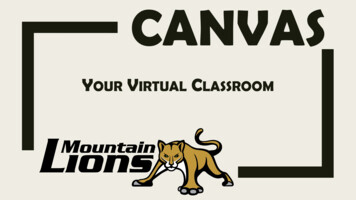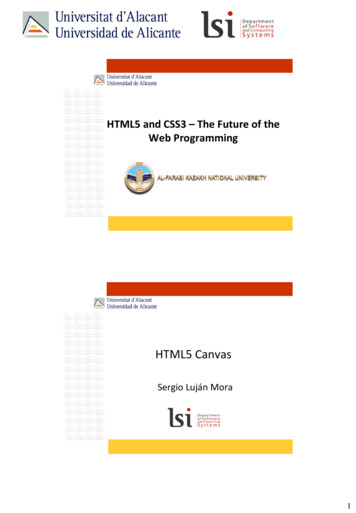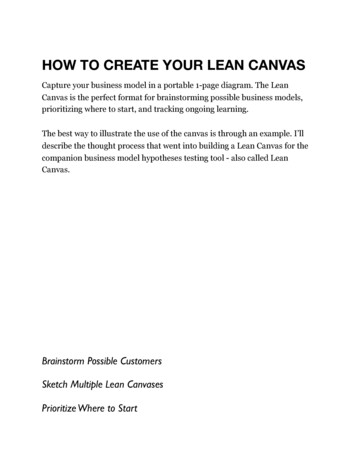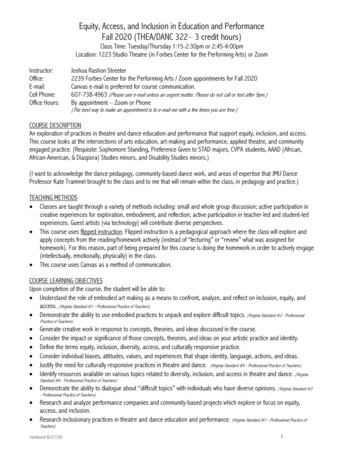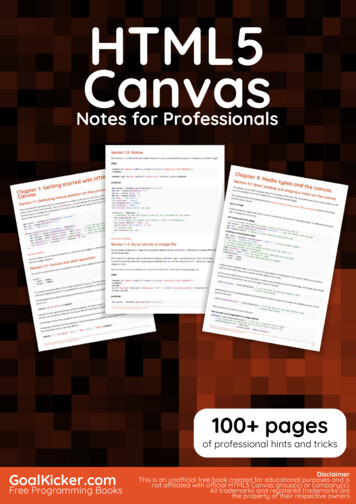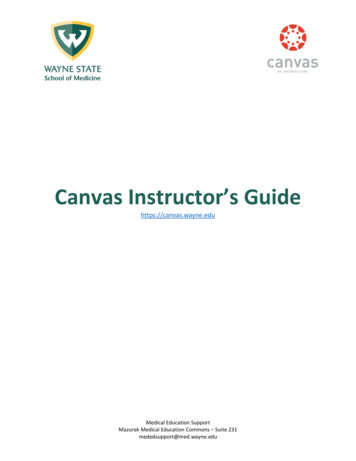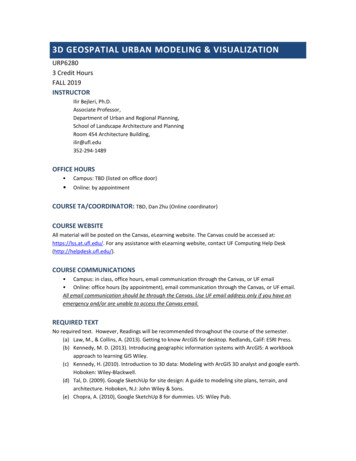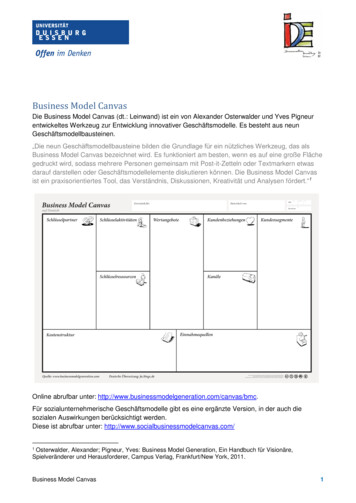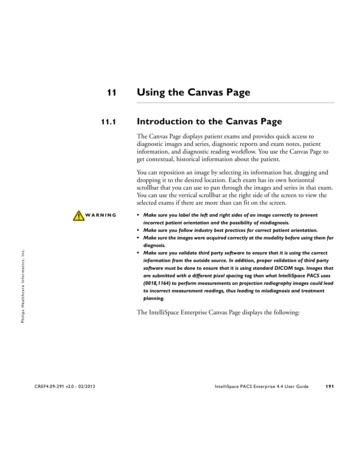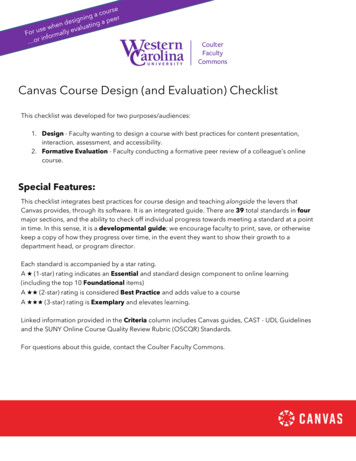
Transcription
Canvas Course Design (and Evaluation) ChecklistThis checklist was developed for two purposes/audiences:1. Design - Faculty wanting to design a course with best practices for content presentation,interaction, assessment, and accessibility.2. Formative Evaluation - Faculty conducting a formative peer review of a colleague’s onlinecourse.Special Features:This checklist integrates best practices for course design and teaching alongside the levers thatCanvas provides, through its software. It is an integrated guide. There are 39 total standards in fourmajor sections, and the ability to check off individual progress towards meeting a standard at a pointin time. In this sense, it is a developmental guide; we encourage faculty to print, save, or otherwisekeep a copy of how they progress over time, in the event they want to show their growth to adepartment head, or program director.Each standard is accompanied by a star rating.A (1-star) rating indicates an Essential and standard design component to online learning(including the top 10 Foundational items)A (2-star) rating is considered Best Practice and adds value to a courseA (3-star) rating is Exemplary and elevates learning.Linked information provided in the Criteria column includes Canvas guides, CAST - UDL Guidelinesand the SUNY Online Course Quality Review Rubric (OSCQR) Standards.For questions about this guide, contact the Coulter Faculty Commons.
Essential Best Practice ExemplarySection 1: Course Information1.1Foundational SufficientlyPresentMinorRevision½ houror lessModerateRevision½ to 2hoursMajorRevision2 hoursNotApplicable CriteriaHome Page provides visual representationof course; a brief course description orintroduction; clear instructions for students(e.g., where to begin) and quick and easynavigation to current content. UDL 2.5Illustrate through multiple mediaOSCQR 1.1 Course includes Welcome and GettingStarted content1.2Foundational Course Navigation is clear and consistent(unused items are hidden). Canvas Guide Navigation Links Mobile Design Consideration UDL 7.3 Minimize threats and distractionsOSCQR 1.2 An orientation or overview is provided forthe course overall, as well as in each module. Learnersknow how to navigate and what tasks are due.1.3Foundational Instructor has provided key learninginformation such as goals, learningobjectives and/or standards as well as coursematerials, supplemental textbooks, andreading lists. UDL 8.1 Heighten salience of goals and objectivesOSCQR 1.9 Course objectives/outcomes are clearlydefined, measurable, and aligned to learning activitiesand assessments.1.4Foundational Instructor has provided class expectationssuch as participation rules, etiquetteexpectations, code of conduct; policies forgrading, late work and make-up work; andtechnology requirements.OSCQR 5.38 Expectations for timely and regularfeedback from the instructor are clearly stated(questions, email, assignments).OSCQR 5.39 Expectations for interaction are clearlystated (netiquette, grade weighting, models/examples,and timing and frequency of contributions).1.5Foundational Instructor has provided contact informationwhich may include biography, availabilityinformation, communication preferences,response time, and picture.OSCQR 1.10 Course provides contact information forinstructor, department, and program.1.6 Course card provides visual representationof the subject by adding an image in CourseSettings. Canvas Guide - Add Image toCourse Card UDL 2.5 Illustrate through multiplemedia1.7 Course contains information and links toinstitutional resources (e.g. library,institutional services, school’s website).OSCQR 1.5 Course includes links to relevant campuspolicies on plagiarism, computer use, filing grievances,accommodating disabilities, etc.
Essential Best Practice ExemplarySection 2: Course sion½ houror lessModerateRevision½ to 2hoursMajorRevision2 hoursNotApplicable CriteriaCopyright law is followed. Course breaksno copyright considerations. Canvas Guide Copyright ResourcesOSCQR 4.33 Course materials and resources includecopyright and licensing status, clearly statingpermission to share where applicable.2.2Foundational All links, files, videos and external URLs areactive and working. Canvas Guide - LinkValidation Learning activities include student-studentinteraction to foster a sense of community(e.g. discussions, constructive collaborationand peer reviews). UDL 8.3 Foster collaboration 2.3 and communityOSCQR 5.42 Course offers opportunities for learner tolearner interaction and constructive collaboration.2.4 Learning activities include student-teacherinteraction (e.g. teacher is actively engagedin authentic conversations and providesquality feedback). UDL 8.3 Foster collaborationand communityOSCQR 5.40 Learners have an opportunity to get toknow the instructor.2.5 Learning activities include student-contentinteraction (e.g. students interact withengaging content and resources) andprovide opportunities for self-assessment. UDL 8.3 Foster collaboration and community UDL9.3 Develop self-assessment and reflection2.6 Content is "chunked” into manageablepieces by leveraging modules (e.g.organized by units, chapters, topic, orweeks). Canvas Guide - Modules MobileDesign Consideration UDL 3.3 Guide informationprocessing, visualization, and manipulationOSCQR 3.16 A logical, consistent, and unclutteredlayout is established. The course is easy to navigate(consistent color scheme and icon layout, relatedcontent organized together, self-evident titles).
Essential Best Practice ExemplarySection 2: Course Content2.7 SufficientlyPresentMinorRevision½ houror lessModerateRevision½ to 2hoursMajorRevision2 hoursNotApplicable CriteriaThere is a “Welcome” or “Let’s GetAcquainted” discussion designed to build asense of community and establish rapport. UDL 8.3 Foster collaboration and communityOSCQR 5.41 Course contains resources or activitiesintended to build a sense of class community, supportopen communication, and establish trust (at least oneof the following - Icebreaker, Bulletin Board, MeetYour Classmates, Ask a Question discussion forums).2.8 2.9 Personalized learning is evident throughopportunities for student choice. UDL 7.1Optimize individual choice and autonomy Modules and items within modules have athoughtful naming convention (e.g. namethe module “Chapter 1: Pandas in theNews,” not just “Chapter 1”). UDL 2.2 Clarifysyntax and structure2.10 Modules begin with anIntroduction/Overview page and end with aConclusion/Summary page to “bookend”each module. UDL 3.1 Activate or supplybackground knowledgeOSCQR 1.2 An orientation or overview is provided forthe course overall, as well as in each module.Learners know how to navigate and what tasks aredue.2.11 Text headers and indention are includedwithin modules to help guide studentnavigation. Canvas Guide - Add TextHeader Mobile Design Consideration UDL 2.2Clarify syntax and structureOSCQR 3.21 Text is formatted with titles, headings,and other styles to enhance readability and improvethe structure of the document.2.12 Opportunities for course feedback arepresent and available to studentsthroughout the duration of course. Instructoruses formal and informal feedback toimprove subsequent course revisions.OSCQR 6.50 Learners have multiple opportunities toprovide descriptive feedback on course design,course content, course experience, and ease of onlinetechnology.2.13 Module completion requirements and/orprerequisites are utilized to provide coursestructure, pacing and flow. Canvas Guide Adding Prerequisites UDL 3.3 Guideinformation processing and visualization
Essential Best Practice ExemplarySection 2: Course Content2.14 SufficientlyPresentMinorRevision½ houror lessModerateRevision½ to 2hoursMajorRevision2 hoursNotApplicable CriteriaExternal tools (e.g., Quizlet, KhanAcademy, Padlet, Nearpod, CK-12) arerelevant to course content and supportactive learning techniques. UDL 5.2 Usemultiple tools for construction and composition2.15 Auto-open Inline Preview is usedthoughtfully. Canvas Guide - Auto-open forInline Preview2.16 MasteryPaths are included. Canvas Guide MasteryPaths UDL 7.2 Optimize relevance, value, and authenticity
Section 3: Assessment of Student Learning vision½ houror lessModerateRevision½ to 2hoursMajorRevision2 hoursNotApplicable 3.2Foundational Best Practice ExemplaryCriteriaDetailed instructions are clearly written toensure understanding to support studentactions. UDL 4.2 Optimize access to tools andassistive technologiesOSCQR 3.19 Instructions are provided and well written. A variety of assessments is used (e.g.,discussions, individual and/or groupassignments and quizzes) to increase learnerengagement and promote active learning. UDL 4.1 Vary the methods for response andnavigationOSCQR 4.29 Course offers access to a variety ofengaging resources that facilitate communication andcollaboration, deliver content, and support learningand engagement.OSCQR 4.30 Course provides activities for learners todevelop higher-order thinking and problem-solvingskills, such as critical reflection and analysis.3.3 Low-stakes (formative) assessments occurfrequently throughout the course to measureknowledge, skills and attitude and occurbefore high-stakes assessments.3.4 High-stakes (summative) assessments areclearly aligned with stated goals, learningobjectives and/or standards.3.5 Assessments include option for instructors touse SpeedGrader to score and provideprompt and high-quality feedback. CanvasGuide - SpeedGrader UDL 8.4 Increase mastery- oriented feedbackOSCQR 6.49 Learners have easy access to a welldesigned and up-to-date gradebook.3.6 Sample assignments are provided toillustrate instructor expectations. UDL 5.3Build fluencies with graduated levels of support forpractice and performanceOSCQR 6.46 Criteria for the assessment of a gradedassignment are clearly articulated (rubrics, exemplarywork).3.7 3.8 Rubrics used to evaluate assignments and/ordiscussions. Canvas Guide - RubricsOSCQR 6.46 Criteria for the assessment of a gradedassignment are clearly articulated (rubrics, exemplarywork). Canvas Outcomes are tied to assessments.Canvas Guide - Outcomes UDL 8.1 Heightensalience of goals and objectives
Essential Best Practice ExemplarySection 4: Course orRevision½ houror lessModerateRevision½ to 2hoursMajorRevision2 hoursNotApplicable CriteriaWeb tools and/or software are utilized toidentify and correct accessibility issueswithin the course (e.g. AccessibilityChecker.) Canvas Guide - AccessibilityChecker UDL 7.3 Minimize threats and distractionsOSCQR 2.15 Any technology tools meet accessibilitystandards.4.2 Accommodation Statement is present andeasily located (e.g., on Home Page orSyllabus). UDL 4.2 Optimize access to tools andassistive technologies4.3 Color enhances the aesthetic appeal andeffectiveness of the course; sufficientcontrast between text and backgroundmakes information easy to read; and color isnot used in isolation to convey meaning.Canvas Guide - Accessibility Checker UDL7.3 Minimize threats and distractionsOSCQR 3.18 There is enough contrast between textand background for the content to be easily viewed.4.4 Images are used to support course content(e.g., banners, headings and icons) andaccompanied by text descriptions (Alt text)or captions for more complex descriptions.Canvas Guide - General Accessibility DesignGuidelines UDL 1.3 Offer alternatives for visualinformationOSCQR 4.35 A text equivalent for every non-textelement is provided ("alt" tags, captions, transcripts,etc.).4.5 Styles (e.g. Paragraph, Heading 2, etc.) areused to format text. Canvas Guide - GeneralAccessibility Design Guidelines UDL 4.2Optimize access to tools and assistive technologiesOSCQR 3.21 Text is formatted with titles, headings,and other styles to enhance readability and improvethe structure of the document.OSCQR 3.22 Flashing and blinking text are avoided.
Essential Best Practice ExemplarySection 4: Course Accessibility4.6 Hyperlink text incorporates the hyperlinkdestination/purpose (avoid raw URLs, e.g.,https://www.canvaslms.com) and includeswords and phrases to provide context forscreen-readers (e.g., use “Canvas Guide Hyperlink” rather than “Canvas Guide”).WebAim - Introduction to Links andHypertext UDL 4.2 Optimize access to tools andassistive technologies4.7 Audio materials (mp3, wav, etc.) areaccompanied by a transcript and videos /screencasts are closed-captioned. CanvasGuide - Create Caption Files UDL 1.2 Offeralternatives for auditory information4.8 Tables are used appropriately and areaccessible. WebAim - Creating AccessibleTables Mobile Design ConsiderationOSCQR 3.24 When possible, information is displayedin a linear format instead of as a table.OSCQR 3.25 Tables are accompanied by a title andsummary description.OSCQR 3.26 Table header rows and columns areassigned.ResourcesBaldwin, S., Ching, Y.-H., & Hsu, Y.-C. (2018). Online course design in higher education: A review of national and statewide evaluationinstruments. TechTrends, 62(3), 46-57. https://doi.org/10.1007/s11528-017-0215-zBaldwin, S., & Ching, Y.-H. (2019). Online course design: A review of the Canvas course evaluation checklist. International Review ofResearch in Open & Distributed Learning, 20(3), 268-282. https://doi.org/10.19173/irrodl.v20i3.4283Best practices for building Universal Design principles into your Canvas courses. (n.d.). Retrieved -design/building udl into canvas.htmlCAST (2018). Universal Design for Learning Guidelines version 2.2. Retrieved from http://udlguidelines.cast.orgMoore, E. (2017, October 16). Implementing Universal Design for Learning on Canvas. Retrieved or-learning-on-canvasOnline Course Best Practices Checklist. (2012). Retrieved from stSP1SUNY Online Course Quality Review Rubric – OSCQR. Retrieved from https://oscqr.suny.edu/Original Course Evaluation Checklist Canvas ContributorsDeonne Johnson, Ph.D., Team Lead, Consultants, InstructureErin Keefe, Principal Consultant, InstructureLily Philips, Team Lead, Instructional Design, InstructureMichelle Lattke, Senior Manager, Learning & Strategy, InstructureTom Gibbons, Trainer, InstructureThis work is licensed under a Creative Commons Attribution-NonCommercial-ShareAlike 4.0 International License.
Design - Faculty wanting to design a course with best practices for content presentation, interaction, assessment, and accessibility. 2. Formative Evaluation - Faculty conducting a formative peer review of a colleague's online course. Special Features: This checklist integrates best practices for course design and teaching alongside the .
